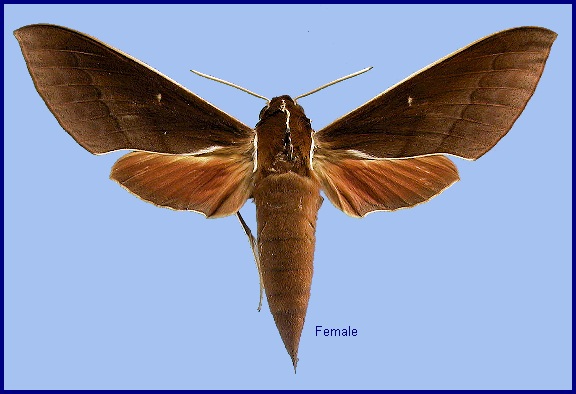
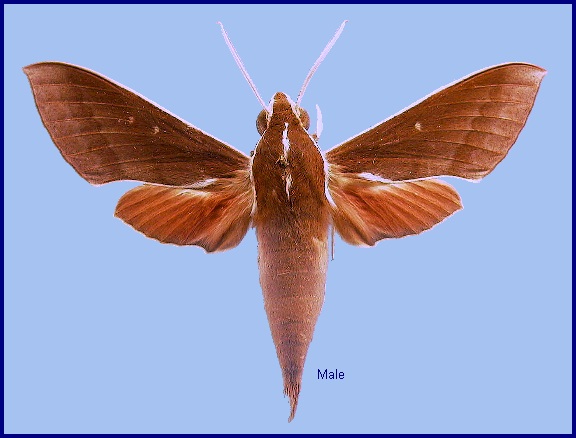
Chaerocampa pallicosta Walker, 1856, List Specimens lepid. Insects Colln Br. Mus. 8: 145. Type locality: [Bangladesh,] Silhet [Sylhet]; [China,] Hong Kong.
Synonym. Chaerocampa pallicosta Walker, 1856.
Wingspan: 70--90mm. Immediately distinguishable from all other species of Theretra by the white forewing costa and discal spot, and a narrow white dorsal line restricted to the thorax. Forewing upperside purplish-brown with only serrate postmedian line clearly visible; discal spot a small white dot; costa highlighted with white. Hindwing upperside orange with a slightly darker, diffuse marginal band. Head and thorax chestnut-brown; thorax with a white dorsal stripe and a similar lateral stripe from tip of palpus to end of thorax; abdomen with first two segments chestnut-brown, rest brownish-pink, paler on the sides. Opening at apex of labial palp segment one partly covered by single long scales from the first and second segments (as in Theretra castanea). Thorax with a white medial line. Forebasitarsus with external row of spines doubled and trebled.
In the male genitalia, uncus weakly sinuate. Gnathos rather narrow, pointed. Valve with about ten large stridulatory scales. Harpe long, slender, horizontal, apex rounded in dorsal view, flattened. Phallus with apical edge dorsally rounded-produced, symmetrical; on left and right sides are dentate processes pointing anteriorly, the left more slender and slightly longer than the right.
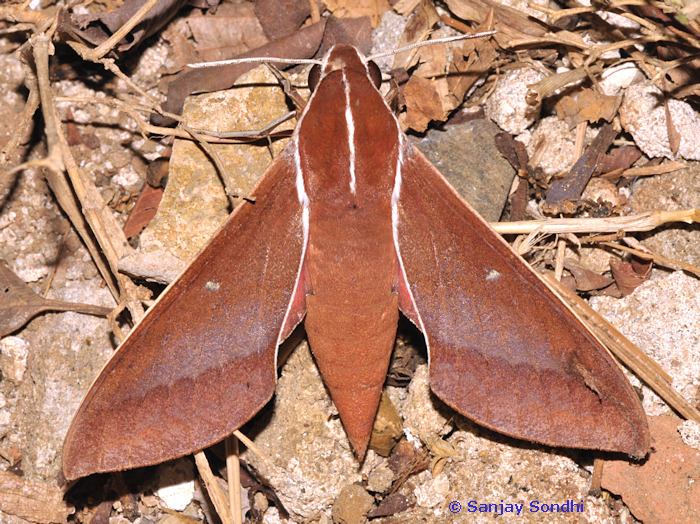
According to Bell & Scott (1937), in southern India the moth does not emerge and lay its eggs till the monsoon is well established, about July, but in Myanmar (Burma) eggs and larvae were found before the end of April. They did not see the moth feeding or come to light.
China: iii-xi (Hong Kong); v (Yunnan); vii (Xizang/Tibet).
OVUM: Green, oval, surface smooth and shiny. Usually found on small bushy plants, close to the ground, and even on seedlings with only a few leaves showing above the ground (Bell & Scott, 1937).
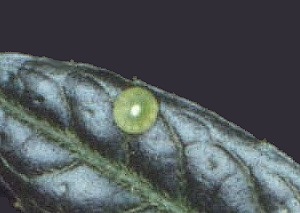
LARVA: Full-fed 60--85mm, width 12mm, horn 5mm. According to Bell & Scott (1937), in the first instar head and body yellowish-green, dorsum of segments 2 to 4 dark green; horn long, thick at base, tapering gently to a strongly bifid tip, the two arms thick at base and shortly conical, shiny black with small black tubercles. Towards the end of this instar the whole body becomes pale grass-green. There are dorso-lateral eye-spots on segments 5 to 11, that on 5 large, round, white with a crescent of black below; these decreasing in size backwards, the white reduced in size in each successive eye-spot until it has disappeared altogether on that of 11.
In the second instar, head orange, and an orange band along front margin of 2; rest of body yellowish-green. Eye-spot on 5 nearly round, pupil enamel-white with a narrow crescent of purple below, the whole edged fairly broadly above and below, narrowly at sides, with black. Remaining eye-spots smaller, longitudinally oval, colour the same as that on 5, but the white pupil oval and oblique (Bell & Scott, 1937).
In the third instar, segments 4 and 5 slightly tumid; head grass-green; body bluish-green dotted obscurely with yellow on 6 to 12. There is a narrow, obscure, dark bluish-green dorsal stripe, and a faint-yellowish subdorsal stripe on 3 and 4. A large round eye-spot is present on 5, its pupil sap-green with broad yellow iris edged narrowly with dark green; the pupil bears a longitudinal oval marking of electric-blue edged narrowly with paler blue, and within the yellow iris are two crescents, one at the top of electric-blue, and a purple one at the bottom. Remaining eye-spots smaller, oval, the oblique, very pale blue pupil edged narrowly above with dark green, below by a purple crescent and then dark green. These eye-spots lying on obscure pale yellowish oblique stripes. Horn long, thin, tapering gently to near tip where it thickens slightly to a bifid tip, the two arms shortly conical (Bell & Scott, 1937).
By the fourth instar segments 4 and 5 much swollen; head grass-green; body pale grass-green covered with a chalk-like bloom, segments 6 to 11 with short thick grass-green stripes around the secondary rings; a narrow dark green dorsal stripe is present. Eye-spot on 5 large, nearly round, coloured as in the third instar, but the pupil of a darker shade; other eye-spots smaller, elongate-oval, very oblique, lying at the same angle as the oblique lateral stripes, pale yellow with a crescent of purple below, the whole edged narrowly above and below with sap-green. The obscure yellowish oblique lateral stripes are interrupted by the oblique eye-spots, except that on 11 and 12, which runs forwards and downwards from base of horn. Horn long, thick at base, tapering evenly to tip, which is slightly, thickened; basal two-thirds straight, distal third gently up-curved; basal third orange, rest translucent pale green, surface shiny and covered with self-coloured, spine-like tubercles.
In the fifth and final instar, head with vertex depressed; true clypeus between one-third and one-half length of head, triangular; false clypeus hardly visible; labrum and ligula large, ligula broad kidney-shaped; surface of head smooth and dull. Body smooth and dull, shaped as in others of the genus, with segment 5 much swollen. Horn short, tapering gently to near tip, then abruptly to a blunt point, gently down-curved; surface dull and sparsely tuberculate (Bell & Scott, 1937).
In the green form, head dull green; labrum green; ligula brownish; basal segment of antenna green, other segments claret-colour; mandible green, a bright yellow band before tip which is reddish-brown. Body greyish-green, segments 5 to 12 with many short brown stripes around the secondary rings, closer together in lateral area, developing into spots below the spiracles. There is a narrow, dark blue dorsal stripe on 2 to 5, continuing diffuse and paler to base of horn. A large round dorso-lateral eye-spot is present on 5, with a longitudinal, irregularly oval black pupil, edged narrowly with electric-blue, then broadly with green of the body-colour; the green edged broadly below, narrowly elsewhere, with primrose-yellow; above and below this a narrow white crescent separated from the yellow by a narrow line of the body-colour; the whole edged fairly broadly with black. This eye-spot closely resembles that on segment 5 of Theretra lycetus. Eye-spots on 6 to 11 elongate-oval, placed obliquely in the same line with the oblique lateral stripes, primrose-yellow in colour edged narrowly with green. The whitish oblique lateral stripes are ill-defined and interrupted by the oblique eye-spots, excepting that on 11 and 12, which runs from the base of horn through the spiracle on 11. Horn dull pink, extreme tip yellowish; legs claret-colour. Spiracles oval, the ends somewhat pointed, pale yellow with a broad central band of violet-green and a narrow, pale brown rim.
There are also dark-coloured forms of the larva in which the green is replaced by pinkish-chocolate and dark chocolate, or by purplish; the eye-spots are as above but darker in shade; those on 6 to 11 sometimes indistinct; horn brown with yellowish tip; spiracles fuscous with a broad border of pale dull ochreous.
As with the eggs, the larva is also found close to the ground or among the thicker parts of the foliage, near the stem (Bell & Scott, 1937).
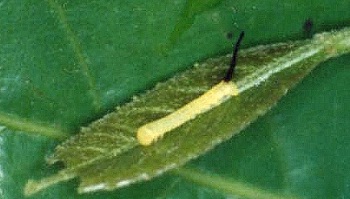
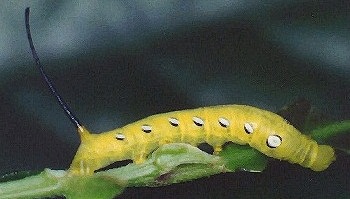
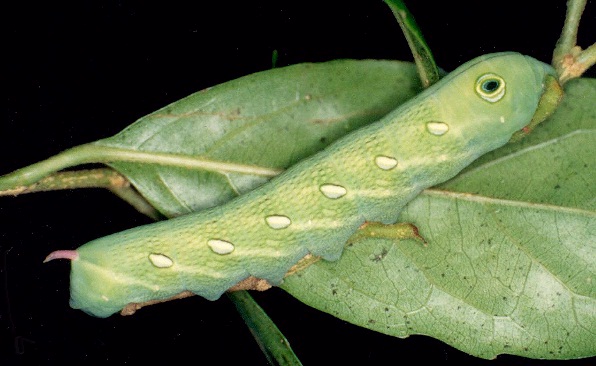
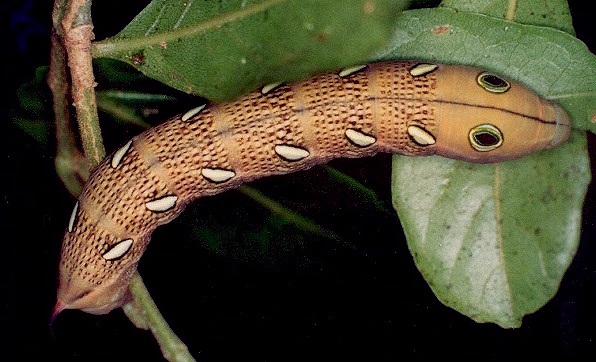
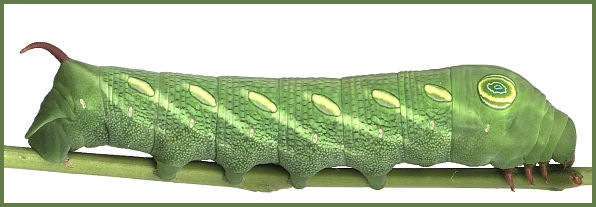
PUPA: 45--60mm, width 13mm. Colour of head, tongue-case and wing-case nearly black; segments 2 and 3 dark wood-brown, 3 and dorsum of abdomen paler wood-brown. Abdomen with a broad faint greenish dorsal stripe. Sides bone-colour mottled and speckled with brown; hind bevels of 8 to 10 greenish; front bevels of 9 to 11 rusty; 12 to 14 blackish ventrally, 13 and 14 also blackish dorsally; venter pale with a narrow black ventral stripe; spiracles and cremaster black, the tips of the teeth white (Bell & Scott, 1937).
Tongue-case projecting somewhat frontad and more ventrad, the edge flattened. Antenna equal to fore leg, which reaches to more than one-half the distance to tip of wing-case, mid-leg to three-quarters that distance; there is a narrow coxal piece. Surface dull; sides of tongue-case, head and thorax coarsely irregularly transversely corrugate; with a very shallow palpal depression. Costa of fore wing tumid and, together with the veins, set with lines of rounded tubercles. Abdomen finely shagreened; front bevels of 9 to 11 superficially pitted; five narrow ante-spiracular ridges on 9; hind margin of 11 tumid and undercut, the front margin of 12 fitting into it telescopically. Spiracle of 2 at the bottom of a very deep triangular depression; remaining spiracles slightly convex ovals, the central slit widening at the ends and with a thick rim (Bell & Scott, 1937).
Cremaster with the sides nearly parallel in basal half, then curving inwards, ending in two conical simply pointed diverging teeth, their bases touching; dorsal surface convex and coarsely striate, ventral concave with an irregular mesial ridge. Under the base of cremaster a deep funnel-shaped depression running forwards into 14, the surface of the hollow very rugose.


Larval hostplants. Recorded in China only on Aporosa octandra, from both Guangdong (Mell, 1922b -- as Aporosa leptostachys) and Hong Kong (Waring et al., 1994 -- as Aporosa chinensis). In India and Burma/Myanmar Theretra pallicosta also feeds on species of Aporosa (Fellowes-Manson, 1909; Bell & Scott, 1937), while in Pakistan it has been recorded on Vitis (Fletcher, 1920). A record from Camellia sinensis in India (Andrews, 1921) is erroneous.
In Thailand, also recorded from Polyalthia cerasoides (Eitschberger & Ihle, 2010).
Unknown.
China: Shaanxi (Xi'an); Yunnan (Changning Co., Songzhishanding, 2800m; Gaoligong Shan); Xizang/Tibet (Xiachayu, Zayu County); Fujian (Jianyang); Guangdong (Guangzhou; Nankunshan); Hong Kong; Hainan.
Taiwan.
From Sri Lanka and India, east through Nepal (Haruta, 1992), Bangladesh and Burma/Myanmar to Hong Kong and Taiwan, and south through Thailand, Laos and Vietnam (Le & Vu, 2024) to Peninsular Malaysia and Indonesia (Sumatra, Java). The Shaanxi record is well north of the rest of the known range of this species and probably represents a vagrant.
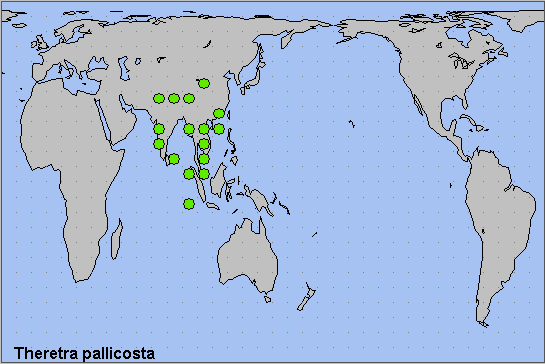
Oriental.
 Return to Sphingidae of the Eastern Palaearctic species list
Return to Sphingidae of the Eastern Palaearctic species list